Henry Clayton & Co, – Atlas Works, near Dorset Square, London, N. W. Patent brick, tile, and pipe machines. These are the champion prize machines of the Royal Agricultural Societies of England, Scotland, Ireland, France, Sardinia, Holland, Austria, Belgium, Hanover, etc. They have obtained the —
First-class prize at the Great Exhibition of all Nations, London, 1851.
Gold medal of honour at the Universal Exposition, Paris, 1855.
Prize medal and diploma at the Great Exhibition, Amsterdam, 1853.
Gold medal prize at the Royal Exposition, Vienna, 1857.
First-class prize of the Royal Polytechnic Society, 1860.
Henry Clayton & Co., inventors, patentees, and manufacturers of the Universal brick making machines, tile making machines, presses, etc. have been patronized by H.R.H. (the late) Prince Consort, H.I.H. the Emperor of Russia, H.M. the Queen of Spain, H.I.H. the Emperor of France, H.M. the King of the Belgians, H.M. the King of Hanover, H.I. M. the Empress of Russia, and by Her Majesty’s Government for home and colonial use, etc.
Brick machines of several sizes and of varied construction, according to the nature of the clay, adapted to the manufacture of solid, tubular, or perforated bricks, of any size or form to order, arranged for working either by steam, water, animal, or hand power.
Drain pipe and tile making machines of various sizes and construction for the manufacture of agricultural drain pipes, sanitary tubes, roofing and paving tiles, and hollow goods of every description.
Presses for bricks and tiles, plain or ornamental.
Clay mills for washing, crushing, pugging, and screening.
Mortar, loam and peat mills.
Steam engines, portable or stationary, of all sizes.
Detailed plans for an improved construction of kilns, drying rooms, and sheds.
Every description of sawing and constructive machinery for contractors’ use, and machinery, tools, and utensils of every kind required in the brick, tile, or pottery manufacture.
The following are selected from a number of favourable notices of these machines:—
“They unquestionably bear evidence of great mechanical ingenuity, and are the most efficient apparatus yet before the public.”— Engineer.
“Clayton’s machines are simple, and judiciously arranged, combining rapidity of production and economy of manufacture.”— Practical Mechanic’s Journal.
“The problem solved.”— Artizan.
“What the sawmill is to the timber, in our opinion, is Clayton’s machine in the manufacture of bricks.”— Mining Journal.
“In this machinery, Mr Clayton has proved his thorough knowledge of the mechanical means required, and of the material he has to deal with.”— Mechanic’s Magazine.
“Cheap and good bricks are now made by these machines;—a subject of national and universal importance.”— Builder.
Machines may be inspected and clays tested at the manufactory. Descriptive catalogues sent free by post.
Below – 24/10/1840 – Leeds Intelligencer – Drains tiles & bricks on sale at Addle, a quantity of superior drain tiles and bricks. Apply to Henry Clayton, Tile and Brick Works, Addle or Mr Carmichael, The Grange, Arthington. near Otley. (Note – SBH – Is this the same Henry Clayton?)
19/07/1845 – Hereford Times – Henry Clayton exhibiting at the Royal Agricultural Society Show, Shrewsbury. Agricultural implements – Henry Clayton, of 21, Upper Park-place, Dorset-square. Patent hand machine, for the manufacture drain pipes, tiles, and bricks; set of various kinds of tools for cutting the drains for pipe tiles and other descriptions drain tiles.
26/07/1845 – Northampton Mercury – Royal Agricultural Society of England – Ploughs, drills and tile machines selected by the judges for further trial (previously to a decision on their merits or an award of prizes) – Henry Clayton, 21, Upper Park-place, Dorset-square, London; hand machine for the manufacture of drain pipes, tiles and bricks invented , improved and manufactured by himself.
17/08/1846 – Clare Journal – The Great National Cattle Show and Agricultural Meeting at Limerick – Prizes – Implements – Henry Clayton, Dorset Square, London for a patent hand machine for the manufacture of drain tiles – 5 sovereigns.
24/07/1847 – Northampton Mercury – Royal Agricultural Society of England, Northampton – Best draining tool for clay land – Mr Henry Clayton, of 21, Upper Park Place, Dorset Square, London. Clayton’s Cycloidal” (or improved Essex shape) draining tools, with polished or ordinary black blades, improved and manufactured by the exhibitor. A variety of tools for cutting the drains for pipe or other description of draining tiles, either in clay, light, or gravelly soils. These tools are made with ground polished blades or with the ordinary black blades, and upon scientific principles as to shape, viz., cycloidal, which produces a permanent cutting edge on their sides, and from the peculiarity of shape giving great strength with lightness to the blade of the tool, and also causes the clay or earth when in a moist and adhesive state to leave the tools much readier than from the old shape of tool; every tool is laid with steel, so that by wear they always keep their edges sharp. It is well known to men accustomed to the use of agricultural spade tools, that a tool with a polished blade requires much less labour its use, and will deliver the soil with greater facility. A complete set of tools for clay land, light land, and gravelly land, consisting of five tools, with polished blades, £2; ditto, with black blades, £1 15s. – A prize of £5.
Below – 19/07/1849 – Norfolk News – Royal Agricultural Society of England – Implements.

Below – 08/12/1849 – Bells Weekly Messenger – Henry Clayton advert.
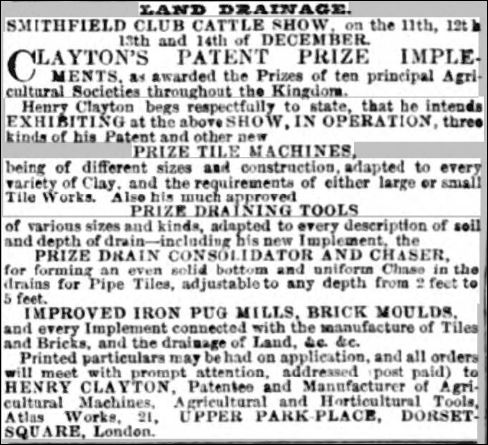
Below – 1851 – Clayton’s brick, tile and pipe making machine.
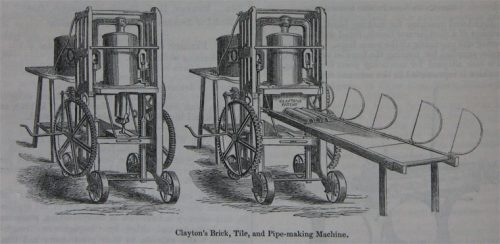
Henry Clayton – Atlas Works, near Dorset Square —Inventor and Manufacturer. Patent double action machine for screening the clay for the manufacture of all kinds of drainage pipes and tiles, roofing and paving tiles, and hollow or solid bricks; it combines the vertical and horizontal plans of working. This double-action machine is illustrated in the annexed cut.
Patent gratings and dies for cleansing clay, being perforated metal plates instead of wires or bars.
Cycloidal shape and other various improved draining tools, for cutting the drains in every description of soils. Patent drain consolidator and chaser, adjustable to every depth of drain, for the tiles to be laid in.
Working drawings (to scale), for the erection of kilns, drying sheds, etc. Improved plan for drying shelves, for drainage tiles, pipes, hollow and solid bricks. Specimens of common and other tiles, and of Roberts’ patent bonded hollow bricks.
Below – 15/02/1853 – South Eastern Gazette – Advert for Henry Clayton and Co.
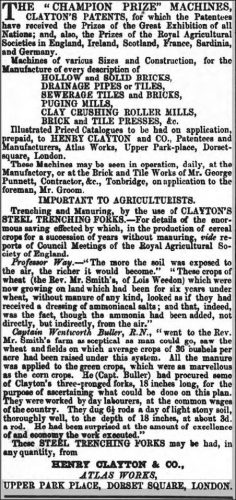
Below – 09/07/1853 – Gloucester Journal – Infringement of Claytons patent. Clayton v Percy.

.
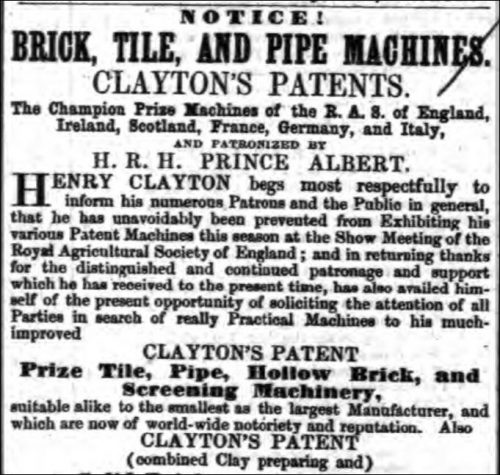
.

Below – 01/04/1854 – Aberdeen Press and Journal.

Below – 13/06/1854 – South Eastern Gazette – Clayton brick making machine court case. Clayton’s patent brick making or pressing, clay screening, tile and pipe machinery. Injunction – See Times 17th Feb. 1854.
The Action which was tried against Mr. W. C. S. Percy, of the Albert Works, Trafford-street, Manchester, the maker of the “Champion brick pressing machines” for infringing Clayton’s Patent, having established the Patent on every point, and an injunction having been granted to restrain Mr. Percy from making or selling, by himself, his servants, or agents the said machines, or any others made in imitation of the invention described in the specification of Clayton’s Patent, and requiring him to account for all the Profits made by the manufacture, or sale, of his “Champion Brick Pressing Machine,” vending, or using the said Machine, or Clayton’s Screening Apparatus for Cleansing the Clay in the Tile, Brick, or Pottery Manufacture, or any other portion of Clayton’s Patent (without his license in writing), will be proceeded against as the law directs.
Dated this 15th day of February 1854. Wilson & Bristow, 1, Copthall-buildings, Solicitor for Mr Henry Clayton, of the Atlas Works, Upper Park-place, Dorset-square, London.
Clayton’s Patent brick-making machines offer a most important and profitable investment.
Clayton’s Patent brick machine is worked by one horse, or applicable to steam or water power, and combines the whole process of pugging the clay and making the bricks at one time.
Clayton’s Patent tile, pipe and hollow brick machines of various sizes and construction.
Clayton’s Patent brick or tile pressing or moulding machines.
Clayton’s pugging mills of various sizes and construction, for tile-clay, brick-earth, mortar, &c.
And every article connected with the brick, tile, and pottery trades. The above machines may be inspected and illustrated catalogues obtained at the manufactory, Atlas Works, Upper Park Place, Dorset Square, London.

Below – 15/07/1854 – Hull Advertiser – Henry Clayton & Co advert.

Below – 22/07/1854 – Claytons patent – testimonials.

.

Below – April 1856 – March 1857 – Practical Mechanics Journal.
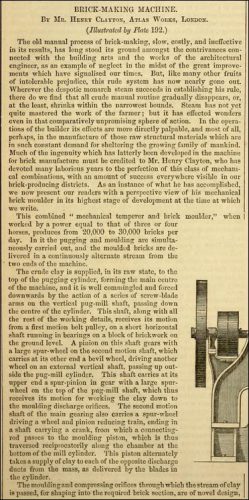
.
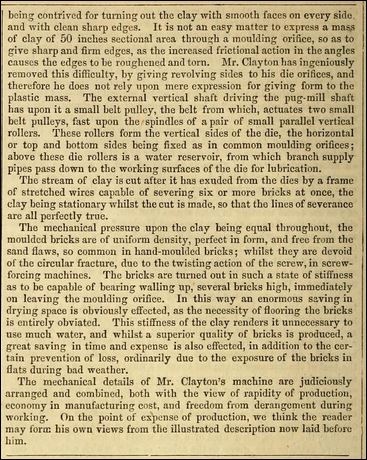
.
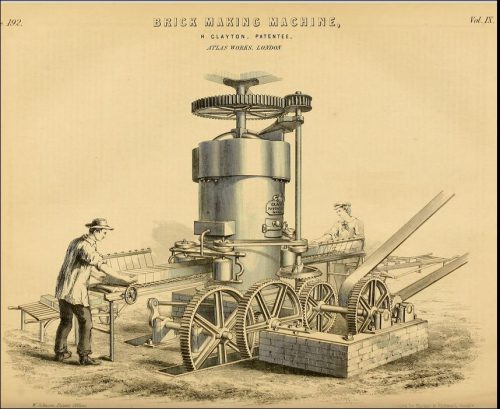
Below – 30/11/1857 – Bell’s Weekly Messenger – Advert for Henry Clayton and Co.

Below – 06/06/1859 – Bedfordshire Mercury – Henry Clayton & Co exporting to Russia.
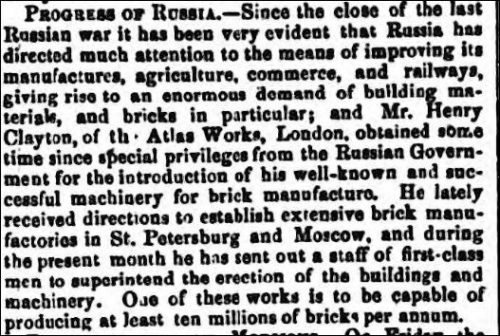
Below – 27/04/1861 – Newscastle Daily Chronicle – Advert for Henry Clayton and Co.

Below – 07/12/1863 – Bells Weekly Messenger – Henry Clayton & Co advert.
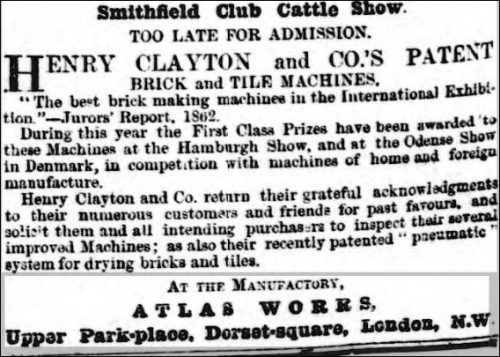
Below – 1864 – Clayton brick making machine.
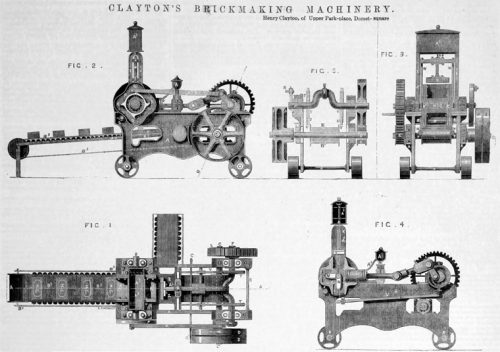
Below – 06/08/1864 – West London Observer – Henry Clayton advert.

Below – 08/08/1864 – Bell’s Weekly Messenger. Open day at the new Atlas Works.

.

.

.

.

.

Below – 05/12/1864 – Bell’s Weekly Messenger – Advert for Henry Clayton and Co.

Below – 1866 – Clayton & Co, Atlas Works, London.

Below – 1869 – Henry Clayton and Howlett – brick making machine with end delivery.
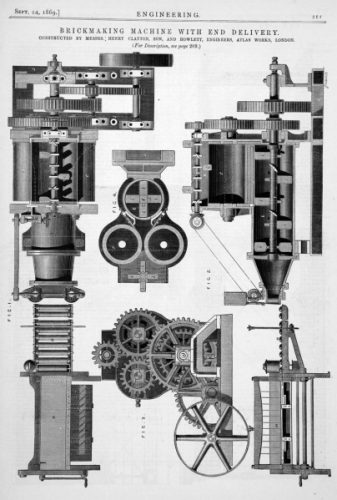
Below – 1870 – Bi chambered semi-dry brick press Henry Clayton and Howlett Engineers, London
Henry Clayton, Son and Howlett of Atlas Works, Harrow Road, London.
The successor to Henry Clayton and Co
Succeeded by Clayton, Howlett and Venables
Also see Clayton, Howlett and Co – brick-makers of Sheffield.
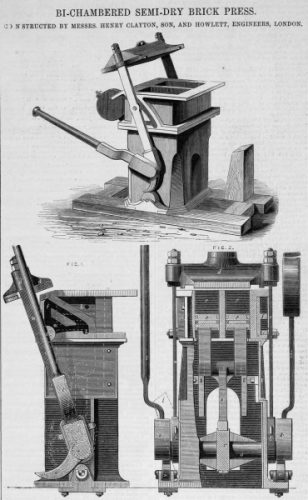
Below – 06/06/1873 – Shipping and Mercantile Cazette – Henry Clayton experiments with peat as a fuel.
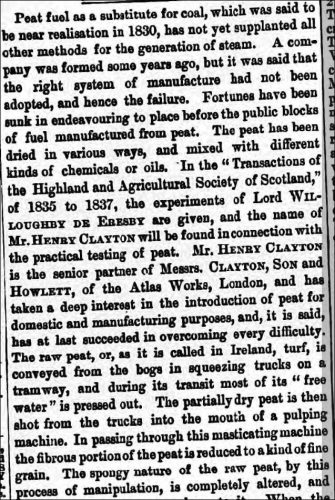 .
.

.
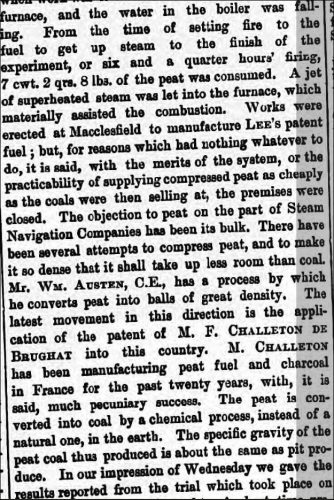
.

Below – 1880 – The Practical Brick and Tile book – Dobson, Edward.

Below – 1880 – Clayton, Howlett and Venables brick and tile machinery Atlas Works, Woodfield Road, Harrow Road, London, W. Established 1821. formerly Clayton, Son and Howlett

Below – 1892 – The Brickmaking Industry in Kuala Lumpur in the Late Nineteenth Century. Shapiza Sharif and Arbaiyah Mohd Noor.
… While bricks were initially made by hand, the introduction of brick-making machinery brought a number of changes that allowed bricks to be made more efficiently.26 Machine-made bricks also required less labour, a point that was demonstrated when machines sold by H. Clayton, Son & Howlett’s reduced the time and the number of workers needed for brick-making in Kuala Lumpur. A ‘Single Chamber Machine’ required just one employee and produced 5,000 bricks per day. A ‘Double Chamber Machine’ could produce 6,500 units per day, but two workers were needed to operate the machine. As the cost of production fell, bricks became cheaper, and the number and quality of bricks manufactured per day increased as equipment was upgraded, with production rising from 10,000 to 16,000 to 25,000 units per day. Moreover, the new machinery produced better quality bricks, and by 1892 machines could make bricks and tiles measuring 6″, 9″, 12″ and 15”.

.
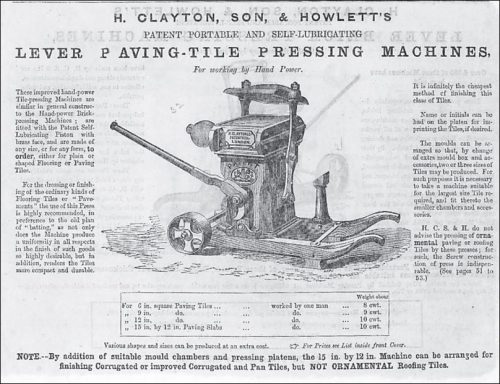
.

1900 – Bought by Brightside Foundry and Engineering Co.
1909 – Clayton advert – Reproduced with the permission of music-ad-world.


































 .
.








